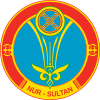Nur-Sultan
Nur-Sultan (US: /ˌnʊərsʊlˈtɑːn/;[8] Kazakh: Nur-Sultan, Нұр-Сұлтан; Russian: Нур-Султан; see also other names), known between 1998 and 2019 as Astana[lower-alpha 1] (Kazakh: Astana, Russian: Астана), is the capital city of Kazakhstan. In March 2019, it was renamed Nur-Sultan in honour of the departing Kazakh president, Nursultan Nazarbayev. It stands on the banks of the Ishim River in the northern part of Kazakhstan, within the Akmola Region, though administered as a city with special status separately from the rest of the region. A 2020 official estimate reported a population of 1,165,983 within the city limits, making it the second-largest city in the country, after Almaty, the previous capital, between 1991 and 1997.[2]
Nur-Sultan Нұр-Сұлтан Astana (Астана, 1998–2019) | |
|---|---|
.jpg)   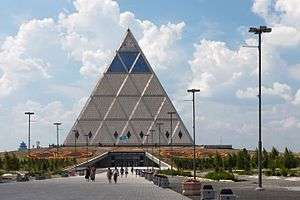 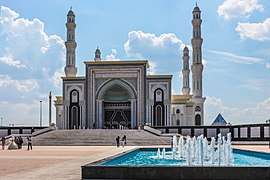 .jpg) Clockwise from top: Nur-Sultan downtown, Kazakhstan Central Concert Hall, Khazret Sultan Mosque, Ishim River, Palace of Peace and Reconciliation, Khan Shatyr Entertainment Center | |
 Nur-Sultan Location of Nur-Sultan in Kazakhstan 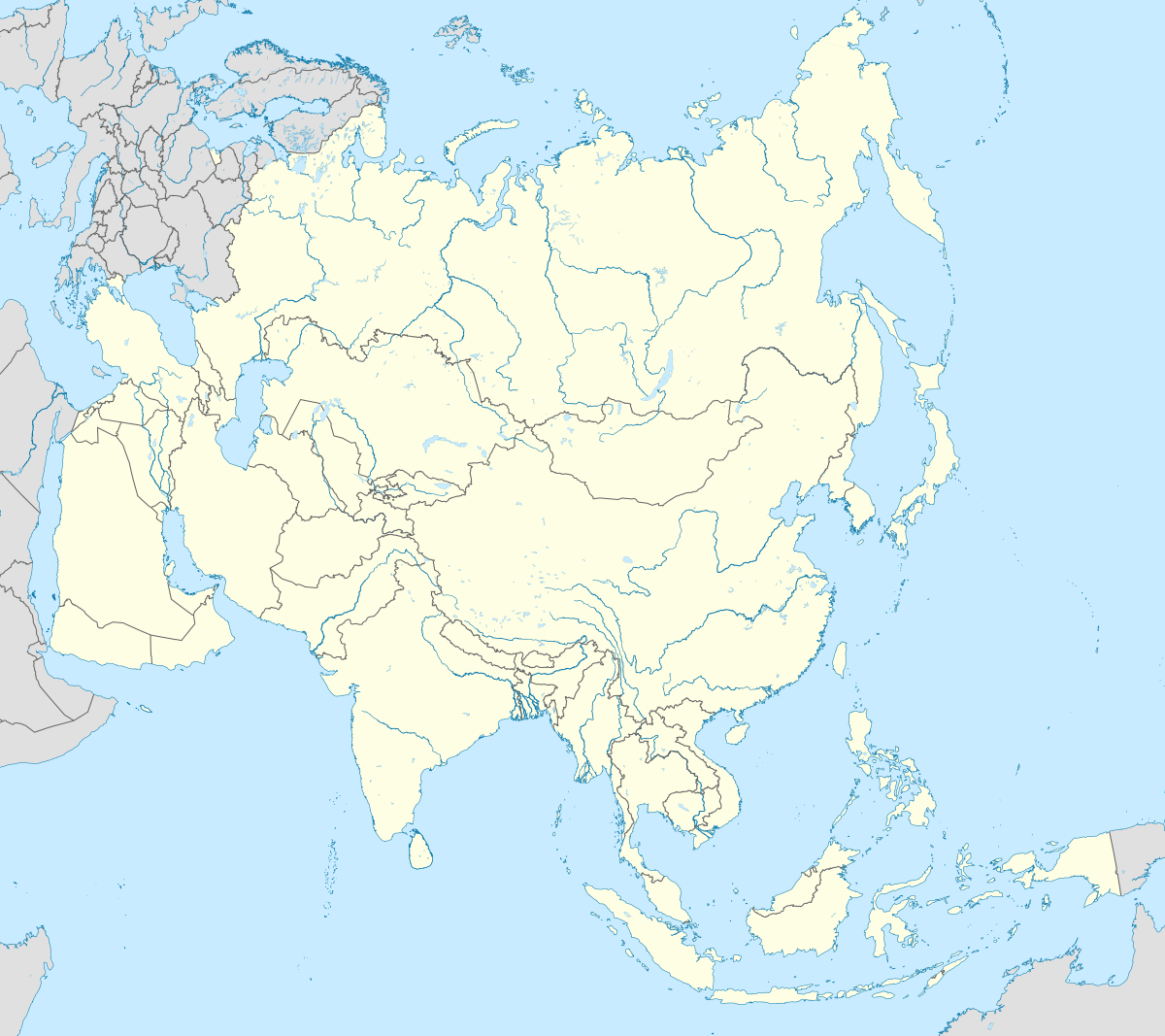 Nur-Sultan Nur-Sultan (Asia) | |
| Coordinates: 51°10′N 71°26′E | |
| Country | |
| Founded | 1830 (as Akmoly)[1] |
| Government | |
| • Type | Mayor–Council |
| • Body | City Council of Nur-Sultan |
| • Akim | Altai Kólginov |
| Area | |
| • Capital city of Kazakhstan | 810.2 km2 (312.8 sq mi) |
| Elevation | 347 m (1,138 ft) |
| Population (1 March 2020)[2] | |
| • Capital city of Kazakhstan | 1,144,755[3] |
| • Metro | 1,200,000 |
| Time zone | UTC+6 (ALMT) |
| Postal code | 010000–010015[5] |
| Area code(s) | +7 7172[6] |
| ISO 3166-2 | AST[7] |
| License plate | 01, Z |
| Website | astana |
The original city of Akmola (then Astana from 1998, and from 2019 Nur-Sultan) became the capital of Kazakhstan in 1997, and since then has developed economically into one of the most modern cities in Central Asia.[12][13] On 23 March 2019, following a unanimous vote in Kazakhstan's parliament, the city was renamed Nur-Sultan, after former Kazakhstan President Nursultan Nazarbayev.[14][15][16]
Modern Nur-Sultan is a planned city, following the process of other planned capitals.[17] After it became the capital of Kazakhstan, the city dramatically changed its shape. The city's master-plan was designed by Japanese architect Kisho Kurokawa.[17] As the seat of the Government of Kazakhstan, Nur-Sultan is the site of the Parliament House, the Supreme Court, the Ak Orda Presidential Palace and numerous government departments and agencies. It is home to a range of futuristic buildings, including many skyscrapers.[18][19][20]
Names
Founded in 1830 as a settlement of Akmoly or Akmolinsky prikaz (Russian: Акмолинский приказ), it served as a defensive fortification for the Siberian Cossacks. In 1832, the settlement was granted a town status and renamed Akmolinsk (Russian: Акмолинск).[1] On 20 March 1961, the city was renamed Tselinograd (Russian: Целиноград, lit. 'City of tselina') to mark the city's evolution as a cultural and administrative center of the Virgin Lands campaign.[21][1] In 1992, it was renamed Akmola, the modified original name meaning "white grave" or "holy city".[1][22] On 10 December 1997, Akmola replaced Almaty as the capital of Kazakhstan. On 6 May 1998, it was renamed Astana, which means "capital city" in Kazakh.[23]
On 20 March 2019, the capital again was renamed from Astana to its current name Nur-Sultan in honor of the long-ruling Kazakh President Nursultan Nazarbayev, shortly after his resignation.[24][25]
History

Early years (1830–1918)
The settlement of Akmoly, also known as Akmolinsky prikaz,[1] was established on the Ishim River in 1830 as the seat of an okrug by a unit of the Siberian Cossacks headed by Fyodor Shubin.[26][27] The name was possibly given after a local landmark—Akmola literally means "a white grave" in Kazakh—although this theory is not universally accepted.[1] In 1832, the settlement was granted town status and named Akmolinsk.[1] The fairly advantageous position of the town was clear as early as 1863 in an abstract from the Geographic and Statistical Dictionary of the Russian Empire. It describes how picket roads and lines connected this geographic center to Kargaly in the East, Aktau fort in the South and through Atbasar to Kokchetav in the West. In 1838, at the height of the great national and liberation movement headed by Kenesary Khan, Akmolinsk fortress was burned.[28] After the repression of the liberation movement, the fortress was rebuilt. On 16 July 1863, Akmolinsk was officially declared an uyezd town.[29] During the rapid development of the Russian capitalist market, the huge Saryarka areas were actively exploited by the colonial administration. To draft regulation governing the Kazakh Steppe the Government of the Russian Empire formed Steppe Commission in 1865. On 21 October 1868, Tsar Alexander II signed a draft Regulation on governing Turgay, Ural, Akmolinsk and Semipalatinsk Oblasts. In 1869, Akmolinsk external district and department were cancelled, and Akmolinsk became the center of the newly established Akmolinsk Oblast. In 1879, Major General Dubelt proposed to build a railway between Tyumen and Akmolinsk to the Ministry of Communications of Russia. In the course of the first 30 years of its existence, the population of Akmola numbered a trifle more than 2,000 people. However, over the next 30 years the city's population increased by three times according to volosts and settlements of the Akmolinsk Oblast. In 1893, Akmolinsk was an uyezd with a 6,428 strong population, 3 churches, 5 schools and colleges and 3 factories.
Soviet era (1918–1991)
During World War II, Akmolinsk served as a route for the transport of engineering tools and equipment from evacuated plants in the Ukrainian SSR, Byelorussian SSR, and Russian SFSR located in the oblasts of the Kazakh SSR. Local industries were appointed to respond to war needs, assisting the country to provide the battle and home fronts with all materials needed. In the post-war years, Akmolinsk became a beacon of economic revival in the west of the Soviet Union ruined by the war. Additionally, many Russian-Germans were resettled here after being deported under Joseph Stalin's rule.[31]
In 1954, Northern Kazakh SSR oblasts became a territory of the Virgin Lands Campaign led by Nikita Khrushchev, in order to turn the region into a second grain producer for the Soviet Union.[32][33] In December 1960, Central Committee made a resolution to create the Tselinniy Krai, which comprised five regions of the Northern Kazakh SSR oblasts.[34] Akmolinsk Oblast was ceased to exist as a separate administrative entity.[34] Its districts were directly subordinated to the new krai administration, and Akmolinsk became the krai capital, as well as the administrative seat of the new Virgin Lands economic region.[34] On 14 March 1961, Khrushchev suggested the city should have a name corresponding to its role in the Virgin Lands Campaign.[35] On 20 March 1961, the Supreme Soviet of the Kazakh SSR renamed Akmolinsk to Tselinograd.[35] On 24 April 1961, the region was reconstituted as Tselinograd Oblast.[34] In the 1960s, Tselinograd was completely transformed. In 1963, work on the first three new high-rise housing districts began.[36] In addition, the city received a number of new monumental public buildings, including the Virgin Lands Palace, a Palace of Youth, a House of Soviets, a new airport, and several sports venues.[37] In 1971, the Tselinniy Krai was abolished and Tselinograd became the centre of the oblast.
Contemporary era (1991–present)
After the dissolution of the Soviet Union and the consequent independence of Kazakhstan, the city's original name was restored in the modified form Akmola.[1] On 6 July 1994, the Supreme Council of Kazakhstan adopted the decree "On the transfer of the capital of Kazakhstan".[38] After the capital of Kazakhstan was moved to Akmola on 10 December 1997, the city was consequently renamed Astana in 1998.[39] On 10 June 1998, Astana was presented as the capital internationally.[40] On 16 July 1999, Astana was awarded the medal and title of the City of Peace by UNESCO.[38] On 19 March 2019, president Nursultan Nazarbayev resigned, and on 23 March the city was renamed Nur-Sultan.[41] While it is officially called Nur-Sultan, the residents still call it Astana, because they were used to the name.
Geography
%2C_satellite_image_2017-07-24.jpg)
Nur-Sultan is almost 1000 km away from the country's largest city and former capital, Almaty. The nearest big cities are Karaganda (200 km) and Omsk in Russia (450 km).
Topography
Nur-Sultan (Astana) is located in central Kazakhstan on the Ishim River in a very flat, semi-arid steppe region which covers most of the country's territory. It is at 51° 10' north latitude and 71° 26' east longitude. The city encompasses 722.0 square kilometres (278.8 sq mi). The elevation of Nur-Sultan (Astana) is 347 metres (1,138 ft) above sea level. Nur-Sultan is in a spacious steppe landscape, in the transitional area between the north of Kazakhstan and the extremely thinly settled national centre, because of the Ishim River. The older boroughs lie north of the river, whilst the new boroughs are located south of the Ishim.
Time
The time offset from the UTC used by Nur-Sultan is 6 hours after UTC, or UTC+6:00. This is also used by most of Kazakhstan and Almaty.
Climate
Nur-Sultan is the second-coldest national capital in the world after Ulaanbaatar, Mongolia, a position formerly held by Canada's capital, Ottawa, until Nur-Sultan attained capital city status in 1997.[42][43] Nur-Sultan has an extreme continental climate with warm summers (featuring occasional brief rain showers) and long, very cold, dry winters. Summer temperatures occasionally reach 35 °C (95 °F) while −30 to −35 °C (−22 to −31 °F) is not unusual between mid-December and early March. Typically, the city's river is frozen over between the second week of November and the beginning of April. Nur-Sultan has a well-deserved reputation among Kazakhs for its frequent high winds, the effects of which are felt particularly strongly on the fast-developing but relatively exposed Left Bank area of the city.
Overall, Nur-Sultan has a humid continental climate (Köppen climate classification Dfb).[44] The average annual temperature in Nur-Sultan is 3.5 °C (38.3 °F). January is the coldest month with an average temperature of −14.2 °C (6.4 °F) and record lowest is in January 1893's cold wave reaching temperatures down to −51.6 °C (−60.9 °F).[45] July is the hottest month with an average temperature of 20.8 °C (69.4 °F).
| Climate data for Nur-Sultan | |||||||||||||
|---|---|---|---|---|---|---|---|---|---|---|---|---|---|
| Month | Jan | Feb | Mar | Apr | May | Jun | Jul | Aug | Sep | Oct | Nov | Dec | Year |
| Record high °C (°F) | 3.4 (38.1) |
4.8 (40.6) |
22.1 (71.8) |
29.7 (85.5) |
35.7 (96.3) |
40.1 (104.2) |
41.6 (106.9) |
38.7 (101.7) |
36.2 (97.2) |
26.7 (80.1) |
18.5 (65.3) |
4.5 (40.1) |
41.6 (106.9) |
| Average high °C (°F) | −9.9 (14.2) |
−9.2 (15.4) |
−2.5 (27.5) |
10.9 (51.6) |
20.2 (68.4) |
25.8 (78.4) |
26.8 (80.2) |
25.2 (77.4) |
18.8 (65.8) |
10.0 (50.0) |
−1.4 (29.5) |
−8.0 (17.6) |
8.9 (48.0) |
| Daily mean °C (°F) | −14.2 (6.4) |
−14.1 (6.6) |
−7.1 (19.2) |
5.2 (41.4) |
13.9 (57.0) |
19.5 (67.1) |
20.8 (69.4) |
18.8 (65.8) |
12.3 (54.1) |
4.6 (40.3) |
−5.4 (22.3) |
−12.1 (10.2) |
3.5 (38.3) |
| Average low °C (°F) | −18.3 (−0.9) |
−18.5 (−1.3) |
−11.5 (11.3) |
0.2 (32.4) |
7.9 (46.2) |
13.2 (55.8) |
15.0 (59.0) |
12.8 (55.0) |
6.6 (43.9) |
0.2 (32.4) |
−8.9 (16.0) |
−16.1 (3.0) |
−1.5 (29.3) |
| Record low °C (°F) | −51.6 (−60.9) |
−48.9 (−56.0) |
−38.0 (−36.4) |
−27.7 (−17.9) |
−10.8 (12.6) |
−1.5 (29.3) |
2.3 (36.1) |
−2.2 (28.0) |
−8.2 (17.2) |
−25.3 (−13.5) |
−39.2 (−38.6) |
−43.5 (−46.3) |
−51.6 (−60.9) |
| Average precipitation mm (inches) | 16 (0.6) |
15 (0.6) |
18 (0.7) |
21 (0.8) |
35 (1.4) |
37 (1.5) |
50 (2.0) |
29 (1.1) |
22 (0.9) |
27 (1.1) |
28 (1.1) |
22 (0.9) |
320 (12.6) |
| Average rainy days | 2 | 2 | 5 | 9 | 15 | 13 | 15 | 13 | 12 | 10 | 7 | 3 | 106 |
| Average snowy days | 25 | 23 | 19 | 6 | 1 | 0.1 | 0 | 0 | 1 | 7 | 18 | 24 | 124 |
| Average relative humidity (%) | 78 | 77 | 79 | 64 | 54 | 53 | 59 | 57 | 59 | 68 | 80 | 79 | 67 |
| Mean monthly sunshine hours | 103 | 147 | 192 | 238 | 301 | 336 | 336 | 294 | 230 | 136 | 100 | 94 | 2,507 |
| Source 1: Pogoda.ru.net[45] | |||||||||||||
| Source 2: NOAA (sun, 1961–1990)[46] | |||||||||||||
Demographics
| Year | Pop. | ±% |
|---|---|---|
| 1989 | 281,252 | — |
| 1999 | 326,900 | +16.2% |
| 2002 | 493,100 | +50.8% |
| 2010 | 649,139 | +31.6% |
| 2016 | 872,655 | +34.4% |
| 2020 | 1,136,008 | +30.2% |
Population
As of January 2020, the population of Nur-Sultan (Astana) is 1,136,008;[2] over double the 2002 population of 493,000.[47]
As of 2018, ethnic Kazakhs made up 78% of the city population, representing an increase from 17% during the country's independence.[48]
Ethnic groups (2020):[49]
Many argue that a drive to attract ethnic Kazakhs northward was the key factor in shifting the capital, which was officially put down to lack of space for expansion in the former capital, Almaty, and its location in an earthquake zone.[50] Nur-Sultan would also be 'closer to the industrial center of Kazakhstan' than Almaty.[51]
In 1989, Tselinograd had a population of 281,000. The ethnic mix was about 17.7% Kazakh, 54.1% Russian and 28.2% other ethnic groups.[52]
By 2007, Astana population had more than doubled since becoming the capital, to over 600,000, and it topped 1 million in 2017. Migrant workers—legal and illegal—have been attracted from across Kazakhstan and neighbouring states such as Uzbekistan and Kyrgyzstan, and Astana is a magnet for young professionals seeking to build a career. This has changed the city's demographics, bringing more ethnic Kazakhs to a city that formerly had a Slavic majority.[50]
Religion
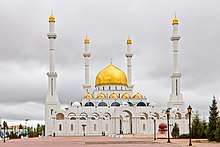
Islam is the predominant religion of the city. Other religions practiced are Christianity (primarily Russian Orthodox, Roman Catholicism, and Protestantism), Judaism, and Buddhism.[53]
The Palace of Peace and Reconciliation was specially constructed in 2006 to host the Congress of Leaders of World and Traditional Religions. It contains accommodations for different religions: Judaism, Islam, Christianity, Buddhism, Hinduism, Taoism and other faiths.
Metropolitan area
The metropolitan area centered upon Nur-Sultan (Astana) includes the Arshaly, Shortandy, Tselinograd and (partially) Akkol districts of Akmola Region. The area contains 1.2 million people.[4]
Economy
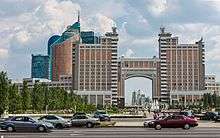
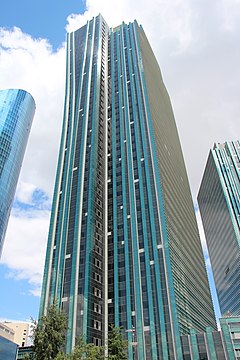
Nur-Sultan's economy is based on trade, industrial production, transport, communication and construction. The city's industrial production is mainly focused on producing building materials, foodstuff and mechanical engineering.
The Astana International Financial Center (AIFC) opened in July 2018 to become a hub for financial services in Central Asia.[54]
Nur-Sultan is the headquarters of state-owned corporations such as Samruk-Kazyna, Kazakhstan Temir Zholy, KazMunayGas, KazTransOil, Kazatomprom, KEGOC, Kazpost and Kazakhtelecom.
The shift of the capital has given it a powerful boost to Nur-Sultan's economic development. The city's high economic growth rate has attracted numerous investors. In the 16 years since Nur-Sultan became the capital, the volume of investments has increased by almost 30 times, the gross regional product has increased by 90 times,[55] and industrial output has increased by 11 times. The city's Gross Regional Product makes up about 8.5 per cent of the republic's Gross domestic product.[56]
The Nur-Sultan – New City special economic zone was established in 2001 to help develop industry and increase the attractiveness of the city to investors.[57] The SEZ plans to commission five projects worth 20 billion KZT (around $108 million) in the Industrial Park No. 1 in 2015.[57] The projects include construction of a plant for production of diesel engines, a fast food complex, temporary storage warehouses and a business center, a furniture factory, and production of military and civil engineering machinery.[57] The new Nur-Sultan /Astana International Financial Centre is due to launch on 1 January 2018.
Nur-Sultan's administration is promoting the development of small and medium-sized businesses through the cooperation of the Sovereign Welfare Fund Samruk-Kazyna and National Economic Chamber. Support is provided by a special programme of crediting.[58] As a result, the number of small and medium-sized businesses increased by 13.7% to over 96,000 compared to the previous year as of 1 July 2015.[59] In addition, the number of people employed in small and medium-sized business increased by 17.8% to over 234,000 people as of 1 April 2015.[59]
Nur-Sultan was included in the list of top 21 intelligent communities of the world, according to the report released by the Intelligent Community Forum in October 2016. The rating list includes the cities, regions and communities which use digital instruments for the construction of local economy and society.[60]
In 2018, Nur-Sultan attracted more than three trillion tenge (US$7.91 billion) in foreign direct investments, a record amount for the city. The growth was achieved due to a large number of construction projects.[61]
Tourism becomes one of the factors that drive economic growth in the city. Nur-Sultan is among the top ten most attractive tourist cities in the Commonwealth of Independent States (CIS).[62]
Diplomacy platform
Nur-Sultan has become a platform for high-profile diplomatic talks and summits on critical global issues. Nur-Sultan has hosted multiple rounds of talks between the Assad regime and Syrian opposition.[63] The 12th Ministerial Conference of the World Trade Organization (WTO) is to be held there in 2020. Since 2003, Nur-Sultan has hosted the Congress on World and Traditional Religions, which is a diverse gathering of religious leaders to discuss religious harmony and ending terrorism and extremism.[64]
Cityscape
.jpg)
Nur-Sultan (Astana) is subdivided into four districts. Almaty District was created on 6 May 1998 by presidential decree. The district's territory encompasses an area of 21,054 hectares (52,030 acres; 81.29 square miles) with a population of 375,938 people. The district has five villages. Yesil District, which is also called left bank of the city, was created on 5 August 2008 by presidential decree. The district's territory encompasses an area of 31,179 ha (77,040 acres; 120.38 sq mi) with a population of 119,929 people. Saryarka District was created on 6 May 1998 by presidential decree. The district's territory encompasses an area of 19,202 ha (47,450 acres; 74.14 sq mi) with a population of 339,286 people. Baykonyr District was created on 16 March 2018 by presidential decree. The district's territory encompasses an area of 18,129 ha (44,800 acres; 70.00 sq mi) with a population of 233 351 people.
In April 1998, the Government of Kazakhstan asked architects and urban planners of international renown to participate in a design competition for the new capital. On 6 October 1998, Japanese architect Kisho Kurokawa was awarded the First Prize.[65] Kurokawa's proposal aimed to preserve and redevelop the existing city, and create a new city at the south and the east sides of the Ishim River, enabling the Symbiosis of the History and the Future.[65]
North of the railway line, which crosses Nur-Sultan in an east–west direction, are industrial and poorer residential areas. Between the railway line and the Ishim river is the city centre, where at present intense building activity is occurring. To the west and east are more elevated residential areas with parks and the new area of government administration to the south of the Ishim River. Here many large building projects are under way; for example, the construction of a diplomatic quarter, and government buildings. By 2030, these quarters are to be completed. Nur-Sultan's chief planner, Vladimir Laptev, wants to build a Berlin in a Eurasian style. He has stated that a purely administrative capital such as Canberra is not one of his goals.
Sport
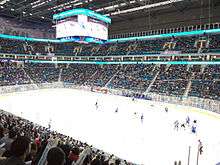
The city has a variety of sporting teams. The major association football team is the FC Astana of the Kazakhstan Premier League. Founded in 2009, FC Astana won four league titles, three Kazakh Cups and two Kazakh Super Cups.[66] Their home ground is the Astana Arena, which is also serves as a home for the Kazakhstan national football team and the FC Bayterek. The FC Bayterek is a member of the Kazakhstan First Division. They were founded in 2012, to develop youth football.[67] The FC Astana-1964 is based in the Kazhymukan Munaitpasov Stadium and plays in the Astana Municipal Football League. The club's most successful years were 2000s, when they won 3 league titles.
Nur-Sultan (Astana) is home to several professional ice hockey teams. The Barys Astana, a founding member of the Kontinental Hockey League in 2008 and based in the Barys Arena.[68] The Nomad Astana and HC Astana play in the Kazakhstan Hockey Championship. The Snezhnye Barsy of the Junior Hockey League is a junior team of the Barys Astana.[69] Nur-Sultan (Astana) annually hosts the President of the Republic of Kazakhstan's Cup ice hockey tournament.[70]
The Astana Pro Team, founded in 2007, participates in the UCI World Tour.[71] The team is one of the most successful cycling teams of recent years, winning several grand tours. The BC Astana of the VTB United League and the Kazakhstan Basketball League is the only professional basketball team in Nur-Sultan (Astana).[72] It is the most successful basketball team in Kazakhstan with three Kazakhstan Basketball League titles and four Kazakhstan Basketball Cups.[72] Its home arena is the Saryarka Velodrome, which is mainly used for track cycling events.[72] The Saryarka Velodrome hosted the UCI Track Cycling World Cup stage in 2011.[73] The Astana Presidential Sports Club was founded in 2012, to combine the main sports teams in Nur-Sultan (Astana).[74] The organization is supported by Sovereign Wealth Fund Samruk-Kazyna.[75] The 2011 Asian Winter Games were partly held in the capital. The Alau Ice Palace, hosted the 2015 World Sprint Speed Skating Championships.[76] The President's Cup tennis tournament is annually held at the Daulet National Tennis Centre.[77]
The martial art palace was opened on 6 July 2019.[78] Sports facilities for five thousand spectators can take part in international competitions in boxing, wrestling, judo, weightlifting, and other Olympic and non-Olympic disciplines. The Palace has a 25-meter pool, fitness and wrestling rooms, a football field, as well as a comfortable hotel. The object will be made available to the pupils of the Sports School.
Education

Nur-Sultan (Astana) has many universities and junior colleges. as of the 2013/2014 academic year, Nur-Sultan had a total enrollment of 53,561 students in its 14 higher educational institutions, a 10% increase from the prior year.[79] The L.N.Gumilyov Eurasian National University is the biggest university in Nur-Sultan with 16,558 students and 1,678 academic staff.[80] It was founded as the result of merging the Akmola Civil Engineering Institute and Akmola Pedagogical Institute on 23 May 1996.[81] The oldest university in Astana is the S.Seifullin Kazakh Agro Technical University founded in 1957.[82] Nazarbayev University is an autonomous research university founded in 2010 in partnership with some of the world's top universities.[83] The Kazakh University of Economics, Finance and International Trade is an economic institution in Nur-Sultan .[84] The Kazakh Humanities and Law Institute is a law university founded by initiative of Ministry of Justice in 1994.[85] The Nur-Sultan (Astana) Medical University was the only medical school in Nur-Sultan until the opening of the School of Medecine at Nazarbayev University in 2014.[86] The Kazakh National University of Arts is the premier music school and has provided Nur-Sultan with highly qualified professional specialists in the field of Arts.[87]
Nur-Sultan schools enrolls about 103,000 students across 83 schools, including 71 state schools and 12 private schools.[88][89] The Miras International School, established 1999, was the first private high school established in Nur-Sultan .[90] The Haileybury Nur-Sultan school was established in 2011, as a branch of the Haileybury and Imperial Service College, an independent school in The United Kingdom. The Nur-Sultan Kazakh-Turkish High Schools are run by the International KATEV foundation. There are Kazakh-Turkish High Boarding Schools for gifted boys and girls, separately and the Nurorda International School.[91] Nur-Sultan hosts two Nazarbayev Intellectual Schools (NIS), including School of Physics and Mathematics and International Baccalaureate world school.[92] The QSI International School of Astana is an international school that provides an American curriculum to its students. The school is a branch of the Quality Schools International that started in the Middle East.[93]
Transportation
City transport
.jpg)
The city transport in Nur-Sultan consists of buses and taxis. Over 720,000 people use public transport daily.[94] There are over 40 bus lines served by more than 1000 vehicles, with over 3000 people working in the public transport sector.[95] Just like buses, share taxis have their own predefined routes and work on a shared basis. There are nine share taxi routes in total.
Trolleybus routes were opened in 1983. There were originally 3 routes, however, by 2006, only one route was left. In 2008, the only trolleybus fleet by the special state commission was declared unprofitable due to debts to the energy supply company and as a result, it was completely closed.
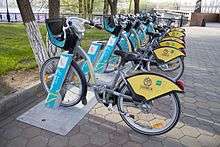
In 2011, the Akimat of Nur-Sultan established a company to implement a series of changes and programmes in the metropolis known as the "New transport system of Nur-Sultan".[96] As the part of these programmes, bus rapid transit (BRT) lines were opened. That same year, the construction of a light rail (LRT) was to begin. It was planned that the first stage of construction of a 16.4-kilometer line, which would've included nine stations, was planned to be completed by 1 December 2013. However, as of May 2020, construction had not begun. In November 2013, President Nursultan Nazarbayev commended the construction of LRT because of the high cost. In exchange, there was a promise to launch high-speed buses. Despite the controversy, the construction of the LRT began in 2017 with the flyovers along to which the trains will pass. The opening is planned for the end of 2020.
Since 2014, the AstanaBike has been operating in Nur Sultan. In 2017, the system consisted of 40 stations with 1000 bicycles. The registration in the system for a season costs 5000 tenge ($28), plus a deposit for an RFID card ($5.50), the first half hour of bike rental is free, the next hour is 100 tenge ($ 0.55). After more than 4 hours, the rent cost 1000 tenge.
Air
Nursultan Nazarbayev International Airport (IATA: NQZ, ICAO: UACC), located 17 kilometres (11 mi) south-east of the city center, is the main gateway for the city's domestic and international civilian air traffic.[97] It is the second-busiest airport in Kazakhstan, with 2,960,181 passengers passing through it in 2014.[98] The airport hosts 13 airlines operating regular passenger flights inside the country and internationally.[99] Air Astana maintains its second-largest hub at the airport.[100] An expected 50% increase in passenger traffic by 2017 has spurred construction of a new terminal with an area of about 40,000 square metres (430,000 sq ft).[101][102]
Railway and roads
Nur-Sultan is located in the center of the country, serving as a well-positioned transport node for rail and automotive networks.[103]
Astana railway station is the city's main railway station and serves approximately 7,000 people each day. A new railway station, Nurly Zhol was built during the Expo 2017 event with a customer capacity of 12,000. Tulpar Talgo is a daily express train to Almaty.[104] Short-term plans include construction of a new railway station in the industrial district; in the vicinity of CHPP-3 a new terminal will be erected for freight cars.[105]
M-36 Chelyabinsk-Almaty and A-343 Astana-Petropavlovsk highways are routed through the city. The strategic geographical positioning of Astana allows the city to serve as a transport and reload centre for cargoes formed at adjacent stations in the area.
River transport
Since 2008, navigation on the Esil River has been organized within the city. The Akimat of the city in the framework of the implementation of the “Shipping Esil” program created a specialized enterprise GKKP “Esil-Astana”. The first navigation was opened in 2008.
Expo 2017
On 1 July 2010, at the 153rd General Assembly of Bureau International des Expositions held in Paris, representatives from then-Astana presented the city's bid to host the Specialised Expo 2017.[106][107][108] Kazakhs concept for this exhibition relates to the impact of energy and social on the modern world. The theme of the Nur-Sultan (Astana) Expo was "Future Energy".[109]
Expo 2017 opened to much fanfare on 10 June 2017, with heads of state from 17 different nations in attendance. It is the first world's fair to be held in Central Asia and its central pavilion, Nur Alem, is the largest spherical building in the world. The two-millionth visitor was registered on 7 August. More than 4 million people visited.
Sightseeings
- Baiterek (monument) is the main attraction and symbol of Nur Sultan.
- Kazakh Eli - (“The Country of Kazakhs”) - a monument on Independence Square. The 91-meter stele is crowned with the Samruk bird (Samұryқ, Simurg) - the king of all birds, the keeper of the peoples. The mythological image of Samruk also includes the second important monument of Kazakhstan - “Baiterek”, in the translation “Tree of Life”, under which the king of birds sits and spreads seeds on the ground from the flapping of wings.
- Nurzhol Boulevard (formerly Water-Green Boulevard) is a recreational pedestrian zone with an Alley of Singing Fountains.
- Akorda is the residence of the President of the Republic of Kazakhstan.
- Independence Palace - a building designed for diplomatic and other events of international level; the building also has a large-scale layout plan of Nur Sultan with existing and future facilities.
- The Palace of Peace and Accord is the Congress Hall, designed for summits and congresses of representatives of traditional Kazakhstan and world religions. Architect Norman Foster
- The Palace of Peace and Reconciliation is the Congress Hall, designed for summits and congresses of representatives of traditional Kazakhstan and world religions. Architect Norman Foster
- “Kazakhstan” - Central Concert Hall.
- "Shabyt" - Kazakh National University of Arts.
- "Zhastar" - the Palace of creativity of schoolchildren and youth.
- Khan Shatyr is the largest shopping and entertainment center (considered the largest tent in the world). Architect Norman Foster
- “Ethnoaul National Cultural Complex”- a unique cultural, tourist and image project EXPO-2017. Ethnoaul is a real opportunity to travel to the past and feel like a real nomad, to feel the atmosphere of centuries past. The national-cultural complex will acquaint visitors with the rich history, culture, art and traditions of the Kazakh people, where anyone who is interested will be transferred to the ethno-cultural environment of the nomadic civilization and fully enjoy the daily and festive life of the aul.
- The triumphal arch "Mangilik el" [2] is a landmark architectural structure, erected in honor of the anniversary of independence of Kazakhstan on the idea of Nursultan Nazarbayev.
- National Space Center [3] Future Energy Museum “Nur Alem” EXPO 2017 - the spherical building “Nur Alem” (Kaz. Shining World). Its height is 100 meters and its diameter is 80 meters.
- Nur Alem is the tallest building with a spherical shape, 30 meters in diameter, than the Ericsson-Glob Arena in Stockholm.
Theaters and concert halls, museums.
There are 27 libraries in Nur-Sultan, whose services in 2011 were used by 153 people for every thousand residents, 8 state museums, which were visited by 415,500 people in 2011 and which conducted 68,514 excursions, 10 recreation parks, in 2011 they 1492.2 thousand visitors were received and 99 events, 6 state museums and 6 cinemas were held.
- The Central Concert Hall Kazakhstan is a unique complex of the young capital designed for events of various levels: concerts of world and domestic stars, celebrations and official meetings, exhibitions, conferences, presentations. Architect Manfredi Nicoletti
- Astana Circus is an entertaining circus institution in the city of Nur Sultan. One of the three main circuses of Kazakhstan; in the territory of the former USSR, one of the newest circuses and one of two unique circus buildings in the form of a “flying saucer” (along with the Kazan circus).
- The National Opera and Ballet Theater named after K. Baiseitova is the youngest musical theater in the country, the bearer of the traditions of the Kazakh and world musical culture, comprehending the classical heritage and realizing the spiritual needs of the renewed Kazakhstani society.
- Astana Opera is a theater founded by the initiative of the first president of Kazakhstan, Nursultan Nazarbayev. The theater building, built in 2013, is recognized as an architectural monument of national importance.
- Kazakh Music and Drama Theater named after K. Kuanyshbaev.
- State Academic Russian Drama Theater named after Maxim Gorky.
- The National Museum of the Republic of Kazakhstan is the largest museum in Central Asia. The museum was created on behalf of The First President of the Republic of Kazakhstan N.A. *Nazarbayev in the framework of the State program "Cultural Heritage"
- Modern Art Museum.
- Presidential Center of Culture - created on the initiative of the head of state N. Nazarbayev. The uniqueness of the research, cultural and educational complex of the capital is that its structure includes a museum, a library, a concert hall.
- ALZHIR (Akmola camp of wives of traitors to the motherland) - The largest Soviet women's camp, one of the three "islands" of the "Gulag Archipelago"
- Atameken is an ethno-memorial complex of nature, architecture and life on a large-scale map of Kazakhstan.
- Museum of the First President of the Republic of Kazakhstan
Sister cities
Nur-Sultan maintains official partnerships with 18 cities. Nur-Sultan's twin towns and sister cities are:
- 1994

- 1996

- 1996

- 1996

- 1998

- 2001

- 2002

- 2004

- 2004

- 2004

- 2004

- 2005

- 2006

- 2009

- 2010

- 2011

- 2013

- 2014

- 2014


Smart city initiative
The Smart Nur-Sultan project is an initiative developed by the then-Astana city administration that incorporates technology-driven solutions in various sectors, like hospitals, schools, the ticket booking system and street lighting.[129] These projects run on an interconnected application, The Smart Nur-Sultan.[129]
See also
References
- Pospelov 1993, pp. 24–25.
- https://stat.gov.kz/region/268012?lang=ru. Missing or empty
|title=(help) - https://www.stat.gov.kz/official/industry/61/statistic/6
- Жулмухаметова, Жадра (31 October 2017). "Чиновники работают над тем, чтобы уместить в Астане два миллиона человек" (in Russian). Archived from the original on 16 November 2017. Retrieved 22 January 2018.
- "Postal Code for Astana, Kazakhstan". Postal Codes Database. Archived from the original on 2 April 2015. Retrieved 10 March 2015.
- "Kazakhstan Country Codes". CountryCallingCodes.com. Archived from the original on 23 September 2015. Retrieved 9 March 2015.
- "ISO Subentity Codes for Kazakhstan". GeoNames.org. Archived from the original on 26 February 2015. Retrieved 10 March 2015.
- "Nursultan". Merriam-Webster Dictionary. Retrieved 13 May 2019.
- "Astana". The American Heritage Dictionary of the English Language (5th ed.). Boston: Houghton Mifflin Harcourt. Retrieved 9 April 2019.
- "Astana". Collins English Dictionary. HarperCollins. Archived from the original on 13 May 2019. Retrieved 9 April 2019.
- "Astana" Archived 13 May 2019 at the Wayback Machine (US) and "Astana". Oxford Dictionaries UK Dictionary. Oxford University Press. Retrieved 9 April 2019.
- "Astana, a city of modern structures". Jakarta Times. Archived from the original on 17 June 2018. Retrieved 17 June 2018.
- "Astana, Kazakhstan: the space station in the steppes". The Guardian. Archived from the original on 21 February 2017. Retrieved 11 December 2016.
- "Новый президент Казахстана подписал указ о переименовании Астаны в Нур-Султан". meduza.io (in Russian). Archived from the original on 23 March 2019. Retrieved 23 March 2019.
- "It's Official: Kazakh Capital Now Called Nur-Sultan". RadioFreeEurope/RadioLiberty. Archived from the original on 23 March 2019. Retrieved 23 March 2019.
- "О переименовании города Астаны – столицы Республики Казахстан в город Нур-Султан – столицу Республики Казахстан – Официальный сайт Президента Республики Казахстан". Akorda.kz. Archived from the original on 23 March 2019. Retrieved 23 March 2019.
- "Astana, Kazakhstan: the space station in the steppes". The Guardian. 8 August 2010. Archived from the original on 11 February 2015. Retrieved 20 February 2015.
- Steven Lee Myers (13 October 2006). "Kazakhstan's Futuristic Capital, Complete With Pyramid". The New York Times. Archived from the original on 19 July 2016. Retrieved 6 October 2014.
- "Astana, the futuristic frontier of architecture". The Guardian. 8 August 2010. Archived from the original on 9 October 2014. Retrieved 6 October 2014.
- Daisy Carrington (13 July 2012). "Astana: The world's weirdest capital city". CNN. Archived from the original on 9 October 2014. Retrieved 6 October 2014.
- The Current Digest of the Post-Soviet Press. Current Digest of the Soviet Press. 1994. p. 20. Archived from the original on 29 June 2018. Retrieved 31 May 2018.
- Paul Brummell (7 September 2018). Kazakhstan. Bradt Travel Guides; Third edition. p. 71. ISBN 978-1784770921.
- "The history of Astana". Akimat of Astana. 19 January 2013. Archived from the original on 7 October 2014. Retrieved 6 October 2014.
- "Parliament approved renaming of Astana as Nursultan". Kazinform. 20 March 2019. Archived from the original on 20 March 2019. Retrieved 20 March 2019.
- "Nursultan, not Astana – Kazakhstan renames capital to honor Nazarbayev". Deutsche Welle. Archived from the original on 22 March 2019. Retrieved 23 March 2019.
- Room, Adrian. (1996). Placenames of Russia and the former Soviet Union : origins and meanings of the names for over 2,000 natural features, towns, regions, and countries. Jefferson, N.C.: McFarland. ISBN 978-0-7864-0042-3. OCLC 34117205.
- "От центра окружного приказа до столицы Казахстана" (краткий исторический обзор истории столицы) [From the center of district order to the capital of Kazakhstan (short historical overview of the history of the capital)] (in Russian). Archive and Documentation Department of Astana. Archived from the original on 23 January 2015. Retrieved 23 January 2015.
- "Revolt of 1837—1847 under the leadership of khan Kenesary". e-history.kz. Archived from the original on 14 January 2015. Retrieved 13 January 2015.
- "History of Astana". e-history.kz. Archived from the original on 14 January 2015. Retrieved 13 January 2015.
- S. Kurmanova. "Deportation of Volga Germans to Kazakhstan: Causes and Consequences" (PDF). e-history.kz. Archived (PDF) from the original on 22 January 2015. Retrieved 13 January 2015.
- Paul Brummell (7 September 2018). Kazakhstan. Bradt Travel Guides; Third edition. p. 71. ISBN 978-1784770921.
- Ian MacWilliam (20 April 1994). "In Virgin Lands, a Dream Ends". The Moscow Times. Archived from the original on 14 January 2015. Retrieved 13 January 2015.
- Kozlov & Gilburd 2013, p. 293.
- Khrushchev 2010, p. 739.
- Kozlov & Gilburd 2013, p. 295.
- Kozlov & Gilburd 2013, p. 296.
- "Astana – the capital of the Republic of Kazakhstan". e-history.kz. Archived from the original on 23 February 2015. Retrieved 23 February 2015.
- "Timeline: Kazakhstan". BBC News. 31 January 2012. Archived from the original on 19 May 2009. Retrieved 24 November 2013.
- "Astana – the capital of the Republic of Kazakhstan". Official site of the President of the Republic of Kazakhstan. Archived from the original on 17 March 2015. Retrieved 10 March 2015.
- "Politics this week". The Economist. 23 March 2019. p. 7. Archived from the original on 24 March 2019. Retrieved 24 March 2019.
Nursultan Nazarbayev, Kazakhstan’s strongman president of 30 years, resigned abruptly. He retains considerable influence; his daughter is the new chairman of the Senate and the constitution gives him lifetime immunity from prosecution. The capital, Astana, is to be renamed Nursultan after him.
- Brian White (9 January 2013). "Ulaanbaatar is the Coldest Capital". The Mongolist. Archived from the original on 26 February 2015. Retrieved 19 February 2015.
- "Still the third-coldest capital, despite balmy temperatures". Canada.com. 4 January 2007. Archived from the original on 6 June 2015. Retrieved 19 February 2015.
- Updated Central, South, Southeast, and Eastern Asian and Siberian Map of the Köppen climate classification system.
- "Weather and Climate-The Climate of Astana" (in Russian). Weather and Climate. Archived from the original on 8 February 2015. Retrieved 8 February 2015.
- "Akmola (Astana) Climate Normals 1961–1990". National Oceanic and Atmospheric Administration (NOAA). Archived from the original on 11 October 2017. Retrieved 8 February 2015.
- "Население Астаны". www.demoscope.ru. Archived from the original on 13 January 2018. Retrieved 31 December 2017.
- Lillis, Joanna (20 March 2019). "Dark Shadows: Inside the Secret World of Kazakhstan". Archived from the original on 22 March 2019. Retrieved 25 November 2019.
- "Численность населения Республики Казахстан по отдельным этносам на начало 2020 года". Stat.kz. Retrieved 3 August 2020.
- "Kazakhstan's Capital Holds a Lavish Anniversary Celebration". EurasiaNet.org. 9 July 2007. Archived from the original on 13 October 2007. Retrieved 9 July 2007.
- Encarta-encyclopedie Winkler Prins (1993–2002) s.v. "Kazachstan. §5. Geschiedenis". Microsoft Corporation/Het Spectrum.
- "Astana". Angelfire.com. Archived from the original on 8 November 2012. Retrieved 21 October 2012.
- "Religion in Astana - Astana". www.astana-hotels.net. Archived from the original on 1 January 2018. Retrieved 31 December 2017.
- "Kazakhstan: Staff Concluding Statement of the 2018 Article IV Mission". IMF. Archived from the original on 29 June 2018. Retrieved 28 June 2018.
- "Astana celebrates 16th anniversary as Kazakhstan's capital". Tengrinews.kz. 9 July 2014. Archived from the original on 19 February 2015. Retrieved 19 February 2015.
- "Poverty in Kazakhstan: Causes and Cures" (PDF). UNDP Kazakhstan. Archived from the original (PDF) on 3 March 2016. Retrieved 19 February 2015.
- "Five projects to be launched in Astana industrial park this year". The Times of Central Asia. 5 February 2015. Archived from the original on 19 February 2015. Retrieved 20 February 2015.
- "Over 170 thousand of people involved in small and medium enterprise in Astana". Akimat of Astana. 14 March 2014. Archived from the original on 16 February 2015. Retrieved 26 January 2015.
- "Number of small and medium-sized business entities grew by 13.7% in Astana". inform.kz. 14 July 2015. Archived from the original on 14 July 2015. Retrieved 14 July 2015.
- "The Smart21 Communities of the Year". www.intelligentcommunity.org. Archived from the original on 5 January 2017. Retrieved 4 January 2017.
- April 2019, Dilshat Zhussupova in Nur-Sultan on 26 (26 April 2019). "Nur-Sultan launches effort to attract another year of record foreign direct investment, says city administration". The Astana Times. Archived from the original on 9 July 2019. Retrieved 9 July 2019.
- "Nur-Sultan, Almaty among 10 most popular tourist cities in CIS". astanatimes.com. 16 October 2019. Archived from the original on 24 October 2019. Retrieved 24 October 2019.
- "Kazakhstan's New Capital Is Growing Up Quick". Forbes. Archived from the original on 29 June 2018. Retrieved 28 June 2018.
- "Vth Congress of Leaders of World and Traditional Religions". UNESCO. 27 July 2015. Archived from the original on 29 June 2018. Retrieved 28 June 2018.
- Whyte 2000, p. 216.
- Достижения [Achievements] (in Russian). Astana F.C. Archived from the original on 17 August 2014. Retrieved 21 August 2014.
- ФК "Байтерек" – новый клуб из столицы [FC Bayterek – the new club from the capital] (in Russian). Total.kz. 30 March 2012. Archived from the original on 21 August 2014. Retrieved 21 August 2014.
- "Barys Astana". Kontinental Hockey League. Archived from the original on 7 October 2014. Retrieved 7 October 2014.
- "Snezhnye Barsy". Junior Hockey League. Archived from the original on 14 October 2014. Retrieved 7 October 2014.
- Paul Bartlett (8 August 2010). "Ice Comes Early for Astana Hockey Fans". Eurasianet.org. Archived from the original on 11 October 2014. Retrieved 7 October 2014.
- "UCI WorldTeams". Union Cycliste Internationale (UCI). Archived from the original on 30 March 2016. Retrieved 5 March 2015.
- "History". BC Astana. Archived from the original on 9 October 2014. Retrieved 7 October 2014.
- "Preview: 2011 UCI Track World Cup Round 1". BritishCycling.org.uk. 27 October 2011. Archived from the original on 12 October 2014. Retrieved 7 October 2014.
- Ilyas Omarov (4 July 2013). "Astana Presidential Sports Club Launched". The Astana Times. Archived from the original on 25 March 2015. Retrieved 21 August 2014.
- Paul Osborne (9 April 2014). "Astana Presidential Sports Club outlines vision to boost Kazakhstan's image". insidethegames.biz. Archived from the original on 21 August 2014. Retrieved 21 August 2014.
- Dmitry Lee (3 March 2015). "Alau Ice Palace Hosts World Sprint Skating Championship, Kazakh Skaters Fail to Reach Podium". The Astana Times. Archived from the original on 15 March 2015. Retrieved 5 March 2015.
- Nazymgul Kumyspaeva. "International President's Cup tennis tournament kicked off in Astana". KazPravda.kz. Archived from the original on 10 October 2014. Retrieved 7 October 2014..
- "Tokayev opened The martial palace". tengrinews.kz..
- "The number of university students in Astana increased by more than 10%". Akimat of Astana. 3 March 2014. Archived from the original on 14 October 2014. Retrieved 8 October 2014.
- В новом учебном году в ЕНУ им. Л.Н. Гумилева будут обучаться 16 558 человек [16 558 students will study in the new academic year at the L.N.Gumilyov Eurasian National University] (in Russian). Info-Tses. 31 August 2014. Archived from the original on 8 December 2015. Retrieved 1 December 2015.
- История и ЕНУ сегодня [History and ENU today] (in Russian). L.N.Gumilyov Eurasian National University. Archived from the original on 8 October 2014. Retrieved 7 October 2014.
- "History of the university". S.Seifullin Kazakh Agro Technical University. Archived from the original on 11 October 2014. Retrieved 7 October 2014.
- "History & Strategy". Nazarbayev University. Archived from the original on 12 October 2014. Retrieved 7 October 2014.
- "Kazakh University of Economics, Finance and International Trade (KazUEFIT)". EURASHE.eu. 20 January 2015. Archived from the original on 12 June 2015. Retrieved 11 June 2015.
- "History of KAZGUU". Kazakh Humanities and Law Institute. Archived from the original on 11 October 2014. Retrieved 7 October 2014.
- "About the University". Astana Medical University. Archived from the original on 27 March 2015. Retrieved 7 March 2015.
- "About us". Kazakh National University of Arts. Archived from the original on 13 October 2014. Retrieved 8 October 2014.
- "5 new schools open doors in Astana today". Kazinform. 1 September 2014. Archived from the original on 11 October 2014. Retrieved 7 October 2014.
- "13,000 to start school this year in Astana". Kazinform. 4 August 2014. Archived from the original on 11 October 2014. Retrieved 7 October 2014.
- "General information about school". Miras International School. Archived from the original on 13 October 2014. Retrieved 8 October 2014.
- "About Us". Archived from the original on 27 April 2018. Retrieved 15 February 2019.
- "Intellectual schools". Nazarbayev Intellectual Schools. Archived from the original on 13 October 2014. Retrieved 7 October 2014.
- "QSI International School of Astana". Quality Schools International (QSI). Archived from the original on 4 December 2014. Retrieved 28 November 2014.
- Ainur Kuramyssova (17 December 2014). "36 Buses Added to Astana's Most Popular Routes". The Astana Times. Archived from the original on 23 February 2015. Retrieved 23 February 2015.
- "Astana Public Transportation". world66.com. Archived from the original on 23 February 2015. Retrieved 23 February 2015.
- Yusup Khassiev (17 October 2012). "Astana: an advancing city in the modern age". International Association of Public Transport. Archived from the original on 23 February 2015. Retrieved 23 February 2015.
- Международный аэропорт Астаны [Astana International Airport] (in Russian). Aeroport.kz. Archived from the original on 22 February 2015. Retrieved 22 February 2015.
- "Passenger traffic". Astana International Airport. Archived from the original on 3 May 2014. Retrieved 16 February 2015.
- "General information". Astana International Airport. Archived from the original on 15 February 2015. Retrieved 16 February 2015.
- "No People's IPO for Air Astana in near future: Samruk Kazyna". Tengrinews.kz. 31 July 2014. Archived from the original on 16 February 2015. Retrieved 17 February 2015.
- "Passenger traffic in Astana airport to increase to 5 million passengers a year by 2017". Akimat of Astana. 26 February 2013. Archived from the original on 16 February 2015. Retrieved 16 February 2015.
- "New Passenger Terminal will be created after the Capitals Airport Reconstruction". Akimat of Astana. 6 November 2014. Archived from the original on 15 February 2015. Retrieved 16 February 2015.
- ""Astana" station". Kazakhstan Temir Zholy. Archived from the original on 15 February 2015. Retrieved 16 February 2015.
- "Kazakh-Spanish trains to become more comfortable". Tengrinews.kz. 28 January 2015. Archived from the original on 2 February 2015. Retrieved 5 March 2015.
- "Astana will construct new railroad station for EXPO-2017". Tengrinews.kz. 17 January 2013. Archived from the original on 4 April 2015. Retrieved 5 March 2015.
- "Future energy – solutions for tackling mankind's greatest challenge". BIE. Archived from the original on 11 August 2016. Retrieved 23 June 2017.
- "Expo2017: Future Energy and Impact on our Lives". Astana Economic Forum. Archived from the original on 23 July 2014.
- "Vision". expo2017astana.com. Archived from the original on 5 May 2016.
- "APCO Worldwide to Drive Energy Innovation Future as Chief Organizing Partner for USA Pavilion at Expo 2017". Archived from the original on 8 July 2017. Retrieved 24 July 2017.
- "Astana city". OrexCa. Archived from the original on 3 April 2016. Retrieved 3 May 2016.
- "Partner Cities". Gdańsk Official Website. Archived from the original on 16 October 2014. Retrieved 9 October 2014.
- "Saint Petersburg to welcome Days of Astana Culture". Kazinform. 5 May 2014. Archived from the original on 15 November 2014. Retrieved 9 October 2014.
- "Tbilisi Sister Cities". Tbilisi Municipal Portal. Archived from the original on 24 July 2013. Retrieved 5 August 2013.
- "Riga's Twin Cities". Municipal Portal of Riga. Archived from the original on 11 November 2011. Retrieved 9 October 2014.
- "Sister Cities of Ankara". Greater Municipality of Ankara. Archived from the original on 9 June 2016. Retrieved 9 October 2014.
- "Miasta partnerskie Warszawy" [Twin cities of Warsaw] (in Polish). City of Warsaw. Archived from the original on 15 October 2014. Retrieved 9 October 2014.
- Bangkok Metropolitan Administration (11 June 2004). "Agreement on establishment of bilateral relations between the Akimat of Astana City of the Republic of Kazakhstan and the City of Bangkok of Kingdom Thailand" (PDF). Archived (PDF) from the original on 22 May 2014. Retrieved 9 October 2014.
- Rafik Valiev (18 September 2014). 10 лет исполнится побратимству городов Астаны и Казани [Astana and Kazan celebrates 10-years anniversary of sister cities status] (in Russian). VechAstana.kz. Archived from the original on 1 May 2015. Retrieved 9 October 2014.
- "About Manila: Sister Cities". City of Manila. Archived from the original on 11 June 2016. Retrieved 2 September 2009.
- "International Cooperation: Sister Cities". Seoul Metropolitan Government. Archived from the original on 10 December 2007. Retrieved 26 January 2008.
- "Twin City Agreement". Greater Amman Municipality. Retrieved 9 October 2014.
- "Sister Cities". Beijing Government. Archived from the original on 18 August 2012. Retrieved 23 June 2009.
- Ilia Lobster (9 September 2009). "Astana-Hanoi: horizons of cooperation". KazPravda.kz. Archived from the original on 9 March 2015. Retrieved 9 October 2014.
- "Ufa and Astana Signed Agreement on Friendship and Cooperation". Ufa City Municipality. Archived from the original on 16 October 2014. Retrieved 17 October 2010.
- Бишкек и Астана — города-побратимы [Bishkek and Astana — Sister Cities] (in Russian). Official website of City Hall of Bishkek. 12 September 2011. Archived from the original on 16 February 2015. Retrieved 9 October 2014.
- "Astana and Finnish Oulu become twin-cities". Tengrinews.kz. 19 April 2013. Archived from the original on 15 December 2014. Retrieved 9 October 2014.
- "Astana and Nice established twin relations". Akimat of Astana. 5 July 2014. Archived from the original on 15 October 2014. Retrieved 9 October 2014.
- "Declaration of intent signed by Akim of Astana and Mayor of Croatias capital". Akimat of Astana. 4 July 2014. Archived from the original on 15 October 2014. Retrieved 9 October 2014.
- "Astana moving closer to becoming smart city". astanatimes.com. Archived from the original on 28 April 2018. Retrieved 27 April 2018.
Further reading
- Pospelov, Evgeni (1993). Имена городов: вчера и сегодня (1917–1992). Топонимический словарь [City Names: Yesterday and Today (1917–1992). Toponymic Dictionary]. Русские словари.CS1 maint: ref=harv (link)
- Kozlov, Denis; Gilburd, Eleonory (2013). The Thaw: Soviet Society and Culture during the 1950s and 1960s. University of Toronto Press. ISBN 9781442644601.CS1 maint: ref=harv (link)
- Khrushchev, Sergei (2010). Никита Хрущев. Реформатор Никита Хрущев. Реформатор [Nikita Khrushchev. Reformer]. Время. ISBN 9785969105331.CS1 maint: ref=harv (link)
- Mallone, Laura (23 September 2016). "The Eccentric Autocrat Who Spent Billions Inventing A City". Wired.
- Whyte, Andy (2000). Kisho Kurokawa, Architect and Associates: Selected and Current Works. Images Publishing. ISBN 9781864700190.CS1 maint: ref=harv (link)
- Vale, Lawrence (2014). Architecture, Power and National Identity. Routledge. ISBN 9781134729210.CS1 maint: ref=harv (link)
